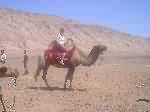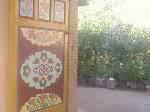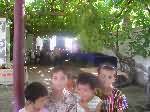- Getting around Lijiang. Dont stay in the Old Towns more than 2 days, there is nothing to do. KRISS Oct 9, 2013 05:46
- 2013 Beijing Temple Fair BENNYLAU Feb 26, 2013 03:29
- Malaysian traveling from KUL - LAX vis Shanghai PVG ZATI_DY Jan 3, 2013 20:15
More than a Road
- Views: 6002
- |Vote: 1 0
- |Add to Favorites
- |Recommend to Friends
The tale of two journeys
At the mention of the ‘Silk Road’ one begins to conjure up a picture of camel caravans piled high with exotic merchandise gliding over sand dunes, from one romantic palm filled oasis to the next. Tall, rugged looking, dark skinned men clad in white flowing robes’ with striped headwear to protect them from the blazing sun by day and shield them from the occasional sand storms that blow across the desert. And by night the silhouette of camels strung out across the dunes backlit by the moon along side tents, richly furnished with rugs and cushions, arrayed around a campfire, the muffled sound of voices floating on the cool night air. Can you smell the campfire, cooking, camels and smoking pipes or hear the pitched discussion of the cameleers as they review the days’ events or talk of getting home?
The tale of a more recent journey on this oft mysterious road has since been penned. Small horse drawn wagons, loaded with personal possessions and traveling provisions rattled and bumped over miles of road guaranteed to shake the wheels off them. Nights were spent in relative safely with other travelers and merchants inside the compounds of simple, lice infested Inns. Fresh provisions and clean sweet water were often scarce. Thieves and scoundrels always ready to fleece the unwary traveler. In cold contrast, it is a journey in reality for three elderly female missionaries’ who after more than twenty years in China chose this road home to England in the late 1920’s. A journey long and arduous from central China to the wild west city of Urumqi where they left the Silk Road and crossed the border into the Russia. The desert today is still as beautiful and unforgiving.
My journey
From my window seat on the plane I watched as the vast Gobi desert stretched northwards beneath us, and the distant, snow capped peaks on the Qinghai Plateau kept pace to the south. Life on the edge of the desert looked precarious as isolated roads snaked across it to join one small green “oasis” to the next.
Very few hardships remain for today’s travelers along the Silk Road. Urumqi, pronounced Wulumuqi is today the capital of Xinjiang and still the largest city in the west. We landed at the very modern airport and made our way into town. Hotels are generally clean, cheap and plentiful although you may have to check a few before you find one to suit your budget. With at least 13 different ethnic groups in Xinjiang it makes for a colourful mix of culture, customs and food. The choices of food are tasty and numerous and a welcome change, especially with breads straight from ovens on the street.
While much of Xinjiang’s historical treasures have been plundered over the years, many new discoveries continue to be unearthed from tombs and now buried, ancient cities. If you make it here to Urumqi, don’t miss the Xinjiang Autonomous Region Museum. Recently remodelled, it houses an interesting display among other things, of a dozen or so mummified bodies of men, women and babies recently discovered in tombs in Xinjiang. What makes these mummies interesting is their origin, thought to be Indo-European, definitely not Chinese.
Leaving early the next morning for Turpan, pronounced locally as Tulufan, from the south bus station was a colourful experience. Touts were out searching for passengers for all point west and south so there is no chance of missing a connection here. Street stalls a plentiful and business is brisk. But it was time for us to go.
The Oasis
Urumqi is really just a large oasis surrounded by irrigated farmland and pastures, which was a pretty sight to watch as we made our way southeast into the arid Turpan Basin, its lowest point being 154m below sea level. While it is a comparatively short bus journey of less than three hours it is also a unique tapestry of terrain, texture and colours. The road follows two rivers that have carved their valleys through a range of moonscape like mountains. The colours ranged from tans and browns to grays and almost black with every bend in the road offering another fascinating scene. Coming out the other side the dun coloured sand stretched as far as the eye could see.
Turpan at first glance looks anything but interesting; coming here with no knowledge of the areas rich history and cultural background you could be forgiven for perhaps not staying around long enough to find out. You will most likely be approached here like almost everywhere by enterprising locals with the offer of hotels, transport and sightseeing options. Take up your options but be wary of how much you pay for the services.
Turpan itself is a small but modern city with both an old and new section and what is of most significant interest lies about its perimeter and surrounding district. How much you see all depends on how much time you have to explore. You can hire a bike here to get around but be warned it can be extremely hot in the summer but this is when the grapes ripen so it’s a great time to visit. You can also hire a vehicle with a driver. Things not to miss are of course the incredibly fruitful Grape Valley, the Jiaohe ruins and the Karez.
The people
Xinjiang is home to the Uyghur, thought to originate somewhere in the Middle East, which of course has many similarities of climate and terrain, and so they brought with them many ideas to this often hostile and arid land. Grapes are just one of the plants that may well have come with the original settlers thousands of years ago. Grape valley lies to the north of Turpan and follows a stream flowing through the desert for several kilometers. A drive along this valley is a cool, colourful and refreshing change from the downtown area. Most people in rural villages including the Uyghur live in gated, courtyard compounds but the Uyghur paint their gates in bright welcoming colours with plants and animals and geometric patterns. Grape vines scramble over trellises shading their courtyards while flowers add a riot of colour to an already inviting and relaxing atmosphere. If you stop by to take a closer look or a photograph you will most likely be invited in to drink hot tea and share some home made bread with all the members of the family. They are a handsome and hospitable people.
The grapes
Grape Valley in the summer is very hot and very green. The roads are almost tunneled over with trees and trellises supporting heavily laden vines dripping with huge bunches of grapes. Small family restaurants line these cool shaded streets, enticing one to take a break from the scorching summer sun. There’s a small museum where you can discover some interesting facts about the 700 odd varieties of grapes grown for fresh fruit, wine, dried fruit and medicinal purposes. There’s a winery in the grounds, traditional style homes and folk dancing displays. A little more exploration will reveal some other venues worth a visit. We caught a rope-walking act, came across the largest oven we have ever seen, capable of baking animals the size of camels whole, giant mud gourds, gushing streams and yes more grapes.
The karez
Karez is the irrigation system dug more than 2000 years ago designed to bring water from the mountains in the north to this dry and thirsty land. A Karez, or head well is dug on higher ground, where melting snow can collect. A long underground tunnel is then built to transport the water down to the farmlands. Vertical wells dug every 20 metres and looking like low anthills dot the countryside aiding construction and giving access to the clear sweet mountain water. A network of over 1000 wells and channels of more than 5000kms in length, constructed entirely by hand continues to bring this precious water to Turpan as it has for over 2000 years.
The ruins
Jiaohe ruins just to the west of Turpan, is strategically located on the spur between and overlooking two rivers. Once a grand ancient city with walls and gates, much of the dwellings have been dug underground, enabling its residents to escape the heat of summer and the bitter cold of winter. Buildings above the ground are constructed of rammed earth or mud bricks as are the modern day grape drying sheds which can been seen in every direction.
Most of the local population sleeps outdoors all summer as it rains so little. On our drive we passed through several small ramshackle villages, with large shady trees lining the narrow streets. Each family farms a small plot of fertile land at the back of their gated, courtyard homes or around the village perimeter. Every home we passed had beds outside, some in courtyards, yet others almost on the street, bedding rolled up to one end. Out early next morning we caught many of the villagers still sleeping soundly, under their thick, warm bedding.
There are many ancient, now half buried cities in the desert with countless stories to be told, along with tombs and graves of kings, priest, philosophers, philanthropist and peasants who lived and died in this harsh land. East of Turpan the Huoyan Shan or Flaming mountains stretch for 100kms into the black sand dunes. This area includes the Astana Graves, the Bezelkik Thousand Buddha caves and the Gaocheng ruins. Once the capital of the Uyghurs, it is even larger than Jiaohe but not so well preserved. Built in the 7th century with city walls, some as thick as 12m forming a rough square of six kilometers and supported by a moat, Gaocheng was an important staging post on the Silk Road.
The desert
On the edge of the black sand dunes, you’ll find a health resort or sanitarium. Guests leave their cool air-conditioned rooms around four in the afternoon, wearing something light, carrying an umbrella, a water bottle or kettle of water and a small spade. They straggle out in ones and twos into the dunes to find an isolated place to dig a hole to bury themselves. The heat of the sand is deemed therapeutic for a variety of ailments. They come, young and old, the fit and the infirm to spend several hours each day buried thus, returning at dusk to wash up and dine in the grape draped outdoor restaurant. With nothing to do for several hours we sat in the relative cool under grape trellises and watched them come and go waiting for the sun to go down.
Our purpose for venturing out into the stark black dunes was a little different. We’d been offered a night in a ‘million star establishment’. It sounded like a ‘once in a million’ experience. All day the temperature and humidity were high so we were hot, sticky and dusty from our days travel. Adding to our discomfort we discovered that our million star establishment did not offer anything more than the stated obvious. We left all the niceties back in the Sanitarium after a simple meal of beef and noodles.
Now it was our turn leave before the gates were locked for the night. So with a sweater, a blanket, a silk sleeping sheet and a water bottle each we made our way out into the darkening dunes. The setting sun cast eerie shadows in the hollows and below the crest of the dunes creating stark contrasts between them. The sun went down but it was a long time before the temperature dropped. The sand was fine and warm and the heat permeated almost 30cms below its surface. We slept fitfully, admiring and sometimes counting the million stars above us and eventually the moon came up. Towards dawn it felt cool, almost comfortable and some of yesterdays heat had left the sand.
While not quite as beautiful as the southern night skies of home, I’m happy to have spent a night in the desert like so many unknown travelers before us. Then the sun came up speading it's soft light across the sky once more.
No real hardship for us-just one night without a shower!!
More photos
Want to see more of the Silk Road?
Why not view my photo series on Turpan, Hami, Jiayuguan and Lanzhou











 Copyright © 1998-2025 All rights reserved.
Copyright © 1998-2025 All rights reserved.